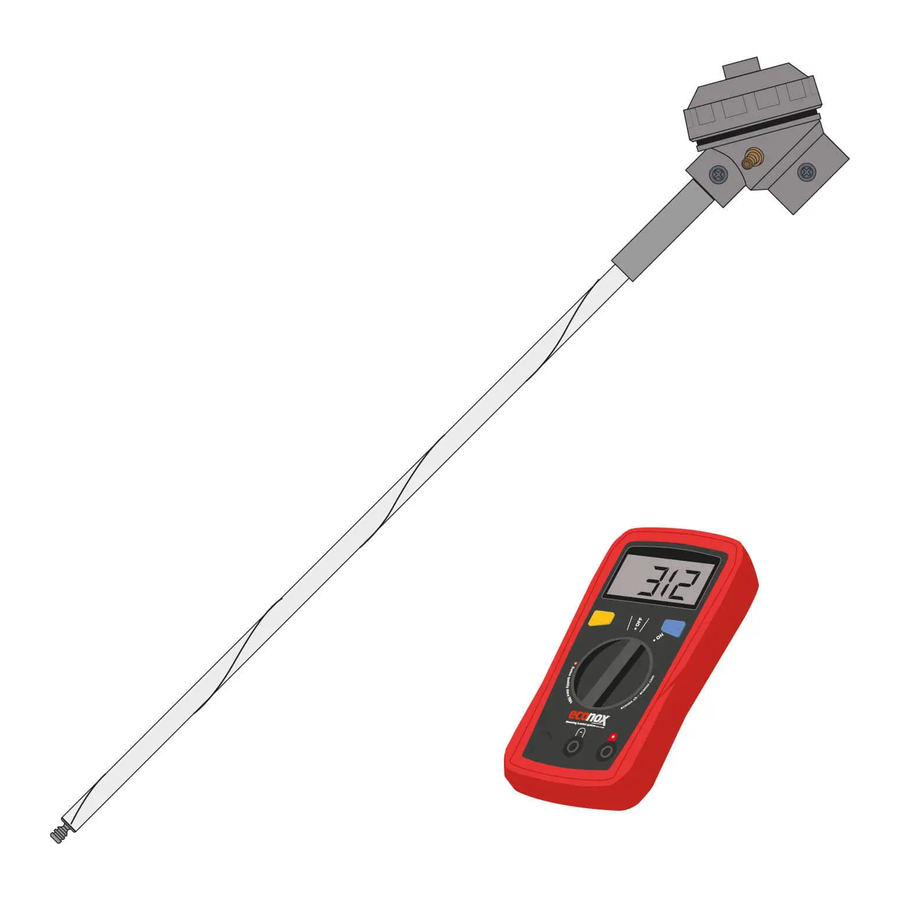Econox CarboProbe CP Plus Manual de instruções de utilização - Página 6
Procurar online ou descarregar pdf Manual de instruções de utilização para Equipamento de teste Econox CarboProbe CP Plus. Econox CarboProbe CP Plus 7 páginas.

Understanding an oxygen probe
Roughly speaking, a reading less than 0.1 represents oxidizing conditions and a reading
over 0.3 represents reduction. Heavy reduction might give a reading of 0.5 or even
more. In between 0.1 and 0.3 the temperature must be known for accurate
interpretation.
In any flame, the air and fuel never mix perfectly. As burning fuel blows past the tip of
the oxygen probe, some of the flame will have excess air and some will be gas rich. This
means that the oxygen reading will jump around as the flame flickers past. This is most
noticeable when there is just the right amount of air to give a neutral flame.
Chart of oxygen concentration from probe reading
mV
700°C
50
1.9 %
100
0.2 %
150
0.02 %
200
0.002 %
250
0.001 %
300
0.00001%
Red= OXIDISING
Air consists of 20.9% oxygen, about 78% nitrogen and some trace gases. In a flame, the
fuel combines with the oxygen in the air and burns, forming carbon dioxide and water
vapor (steam). Inside a kiln, there is a mixture of fuel, oxygen, carbon dioxide, steam
and nitrogen. The amount of each of these depends on the amount of fuel and air in the
flame.
Oxidizing flame
With excess air, there is typically over 2% oxygen in the exhaust gas, but it can be
almost up to the limit of 20.9%. This is called an "oxidizing" flame.
Neutral flame
With exactly the right amount of air for the fuel, there is a "neutral" flame. Even in ideal
conditions, there will be some fuel and some air that cannot find each other to burn
completely. A little unused fuel and air will be in the exhaust gas leaving the kiln. There
is typically anything from 0.02% to 2% unused oxygen in the exhaust.
Reducing flame
With too little air, there will be unburnt fuel in the exhaust gas. This is called a "reducing"
flame. Many people say that there is no oxygen under these conditions, but there will
always be some unused oxygen in the exhaust. It might be less than 0.02%. It might be
less than 0.000001%, but it is there and it can be measured.
There is no sharp distinction between oxidizing, neutral and reducing. There is a smooth
variation from one to the next, so the above figures are only guidelines.
Checking temperature using the CarboProbe CP plus
When the probe is ready to use, connect the probe to the meter. Select the "temperature"
position. The meter will display the thermocouple signal from the thermocouple in mV.
X:\Fiches tech. - Normalisation\ECONOX\Normalisation\Mode d'emploi\PDF\sonde
800°C
900°C
2.4 %
2.9 %
0.3 %
0.4 %
0.03 %
0.06 %
0.004 %
0.01 %
0.0004 %
0.001 %
0.00005%
0.0001%
Green= NEUTRAL
1000°C
1100°C
3.4 %
3.9 %
0.5 %
0.7 %
0.09 %
0.13 %
0.01 %
0.02 %
0.002 %
0.004 %
0.0004%
0.001 %
Blue= REDUCING
1200°C
1300°C
4.3 %
4.8 %
0.9 %
1.1 %
0.18 %
0.25 %
0.04 %
0.06 %
0.01 %
0.01 %
0.002 %
0.003 %
6/7
